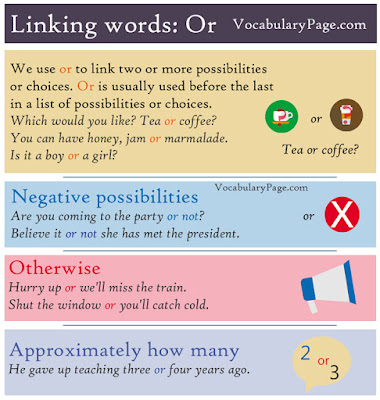We use or to link two or more possibilities or choices. Or is usually used before the last in a list of possibilities or choices.
The phrase or not can be used to show negative possibilities.
- Are you coming to the party or not?
- Believe it or not she has met the president.
- I don't know if his story is true or not.
After a negative verb, use or, not and.
See also: And
- I don't want cake or ice cream [=I don't want cake and I don't want ice cream].
Otherwise
We can use or to say what the result will be if someone does not do something
- Hurry up or we'll miss the train.
- Shut the window or you'll catch cold.
Approximately how many
We use or between two similar numbers to show that we are giving an approximate amount or number.
- He gave up teaching three or four years ago.
Warning
When or is used with two or more singular nouns, the verb should be singular.
When or used with two or more plural countable nouns, the verb should be plural.
Either...or...
The phrase either...or... can be used to emphasize possibilities.
- It's either white or grey. I can't remember its colour.
- The information is either true or false.
- Either you wash the dishes, or you hoover the room.
Neither...nor... is the opposite of either...or... and used to join two or more negative alternatives.
- Neither I nor my wife enjoyed the trip.
Or something
When we are not sure about a group of things or possibilities, we can use or with words such as something or anything.

Comments
Post a Comment